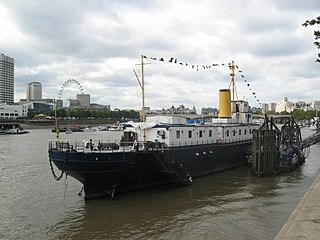See also
- SS President, 19th-century steamer
- President (1924 steamboat), 20th-century steamer
- USS President
Five ships and one shore establishment of the Royal Navy have been named HMS President, after the office of president meaning "one who presides over an assembly". In the case of the first two British ships, the name may have applied to the Lord President of the Privy Council.
This ship-name lapsed from 1660 to 1806, when it was revived by the capture of the French frigate Président, and then perpetuated by the 1815 capture of the American super-frigate USS President. These captures were commemorated by a new *HMS President, which survived from 1829 till 1903, and which passed the name to a series of Presidents of which three survive to this day.
Eleven ships of the Royal Navy have been named HMS Antelope, after the Antelope:
Fifteen ships of the Royal Navy have been named HMS Enterprise while another was planned:
Sixteen ships and two shore establishments of the Royal Navy have been named HMS Fox, after the fox.
Eight ships of the Royal Navy have borne the name HMS Andromeda, after the Greek heroine Andromeda.
Ten ships of the Royal Navy have been named HMS Triumph. Another was planned, but renamed before being launched:
Sixteen ships of the Royal Navy have been named HMS Mermaid after the mermaid:
Several vessels of the Royal Navy have been named HMS Nonsuch, presumably named after Nonsuch Palace:
Eighteen ships of the Royal Navy have borne the name HMS Eagle, after the eagle.
Eighteen ships of the Royal Navy have borne the name Hunter:
Twelve ships and two shore establishments of the Royal Navy have been named HMS Defiance. Others have borne the name whilst serving as depot ships and tenders to the establishments:
Nineteen ships and a shore establishment of the Royal Navy have been named HMS Drake after Sir Francis Drake or after the drake:

HMS President is a retired Flower-class Q-ship that was launched in 1918. She was renamed HMS President in 1922 and moored permanently on the Thames as a Royal Navy Reserve drill ship. In 1982 she was sold to private owners and, having changed hands twice, served as a venue for conferences and functions as well as the offices for a number of media companies. She has been moved to Chatham on the Medway in Kent since 2016, but is due to return to the capital. She had the suffix "(1918)" added to her name in order to distinguish her from HMS President, the Royal Naval Reserve base in St Katharine Docks. She is one of the last three surviving Royal Navy warships of the First World War. She is also the sole representative of the first type of purpose built anti-submarine vessels, and is the ancestor of World War II convoy escort sloops, which evolved into modern anti-submarine frigates.
Sixteen ships of the Royal Navy have been named HMS Pelican, after the bird, while another was planned:
President most commonly refers to:

HMS President is a "stone frigate", or shore establishment of the Royal Naval Reserve, based on the northern bank of the River Thames near Tower Bridge in Wapping and is in the London Borough of Tower Hamlets.
Sixteen ships of the Royal Navy have borne the name HMS Alert, while another was planned:
Twenty-two ships of the Royal Navy have borne the name HMS Falcon. They are named after an exceptionally fast bird of prey.
Thirty-nine vessels of the Royal Navy and its predecessors have borne the name Swallow, as has one dockyard craft, one naval vessel of the British East India Company, and at least two revenue cutters, all after the bird, the Swallow: